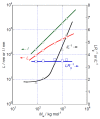Conformation and Structure of Hydroxyethyl Cellulose Ether with a Wide Range of Average Molar Masses in Aqueous Solutions
- PMID: 36365525
- PMCID: PMC9657194
- DOI: 10.3390/polym14214532
Conformation and Structure of Hydroxyethyl Cellulose Ether with a Wide Range of Average Molar Masses in Aqueous Solutions
Abstract
The solution properties of a water-soluble chemically modified cellulose ether, hydroxyethyl cellulose (HeC), were examined using static light scattering (SLS), dynamic light scattering (DLS), small-to-wide-angle neutron scattering (S-WANS), small-to-wide-angle X-ray scattering (S-WAXS) and viscometric techniques at 25 °C. The examined HeC samples had average molar substitution numbers ranging from 2.36 to 2.41 and weight average molar masses (Mw) that fell within a wide range from 87 to 1500 kg mol-1. Although the relationship between the determined radius of gyration (Rg) and Mw was described as Rg ∝ Mw~0.6, as is observed usually in flexible polymer solutions in good solvents, the observed scattering vector (q) dependencies of excess Rayleigh ratios were well interpreted using a rigid rod particle model, even in high-Mw samples. Moreover, the ratios of the formed particle length (L) evaluated assuming the model for rigid rods to the determined Rg showed the relationship LRg-1 ~ 3.5 irrespective of Mw and were close to those theoretically predicted for rigid rod particle systems, i.e., LRg-1 = 12. The observed SLS behavior suggested that HeC molecules behave just like rigid rods in aqueous solution. As the L values were not simply proportional to the average molecular contour length calculated from the Mw, the chain conformation or structure of the formed particles by HeC molecules in aqueous solution changed with increasing Mw. The q dependencies of excess scattering intensities observed using the S-WANS and S-WAXS experiments demonstrated that HeC molecules with Mw less than 200 kg mol-1 have a diameter of ~1.4 nm and possess an extended rigid rod-like local structure, the size of which increases gradually with increasing Mw. The observed Mw dependencies of the translational and rotational diffusion coefficients and the intrinsic viscosity of the particle suspensions strongly support the idea that the HeC molecules behave as rigid rod particles irrespective of their Mw.
Keywords: dynamic light scattering; hydroxyethyl cellulose; radius of gyration; rotational diffusion coefficient; small-to-wide-angle X-ray scattering; small-to-wide-angle neutron scattering; static light scattering; translational diffusion coefficient; weight average molar mass.
Conflict of interest statement
The authors declare no conflict of interest.
Figures









References
-
- Érez S.P., Samain D. Structure and Engineering of Celluloses. Adv. Carbohydr. Chem. Biochem. 2010;64:25–116. - PubMed
-
- Hubert E. Verfahren zur Darstellung von Cellulosederivaten. DE 363, 192. German Patent. 1920
-
- Thomas E.B., Oxley H.F. Manufacture of Derivatives of Cellulose and Other Polymeric Hydroxy Compounds. US2135128A. U.S. Patent. 1938 November 1;
-
- Kamide K. Cellulose and Cellulose Derivatives. Elsevier; Amsterdam, The Netherlands: 2005. Molecular Characterization and its Applications. Chapters 2–3.
Grants and funding
LinkOut - more resources
Full Text Sources
Research Materials
Miscellaneous

